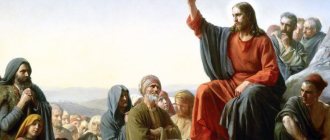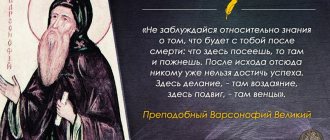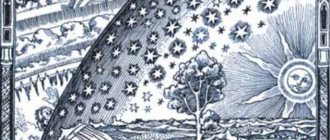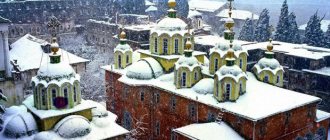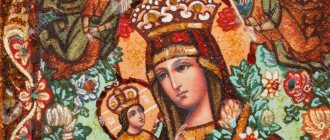Sewing is a traditional activity in monasteries. According to Church tradition, the Mother of God herself was a skilled seamstress, so it is not surprising that the monks loved this craft so much. Our monastery is no exception. One of the first workshops that appeared in the Vvedensky Monastery was a sewing workshop. The monastic family grew quickly, the sisters needed monastic clothes, so seamstresses needed to sew not only for church needs, but also for everyday needs. When there were more priests in the monastery, the sisters began to sew liturgical clothes. Now, 24 years after the founding of the monastery, three sewing workshops have been established in the monastery. The first workshop, the sacristy, is engaged in sewing priestly vestments: phelonions, vestments, stoles, armbands, belts, clubs, legguards, as well as church vestments for the throne and altar. Bookmarks for liturgical books and bags for prosphora are made. In the second workshop, the sewing sisters, they make monastic clothes: they sew robes, hair shirts, cassocks, cassocks, belts, kamilavkas, apostolic shirts, and scarves. Priestly robes and cassocks are also made here. In the embroidery workshop they embroider paramanas, bookmarks, and airs. Lent, according to tradition, is the time for monastic tonsure. For the sisters who are obedient in the sewing workshop, this is the “hottest time.” Not surprising, because for each tonsured sister it is necessary to prepare a full set of vestments, from shoes to a cross and rosary. All parts of the monastic vestment have their own symbolism; in fact, the clothing of a monk is the clothing of a warrior, a warrior of Christ; like a warrior going to the battlefield, each monk receives a kind of armor that will help him protect himself from the arrows of an invisible enemy. People often ask: why are monastic robes black? To this the holy fathers answer this way: “The most sacred image of a monk... is also called the garment of repentance, as (a way of life) mournful, humble and self-deprecating, not tolerating excesses and alien to any human passion, not only not being carried away by any worldly thoughts, words, and deeds , but also renouncing and fleeing from worldly worries... That is why the monk’s clothes are dark, because he remembers death and eternal mourning, he does not live this life, but longs for another - an imperishable life, to which he strives intensely" (St. Simeon Thessalonian). There is also this explanation for the black color of monastic robes: black color is the absence of color as such, a color outside the color spectrum, outside passion; monks, “monks”, who have left everything in this world, including color, strive for peace in God. In the rite of monastic tonsure, every detail of the monastic vestment is described as a detail of military vestments, as the clothing of timeless life and at the same time, as the clothing of one struggling on the path of spiritual achievement. First, the person being tonsured is dressed in a hair shirt - “clothing of voluntary poverty, non-acquisitiveness and patience of all sorrows and oppression” - a long undershirt made of coarse linen or a tunic. In ancient times, the hair shirt was made entirely of coarse camel hair and, when put on, caused pain to the monk, reminding him of the need to bear sorrows without complaint. A paraman is put on the hair shirt - a quadrangular cloth with a cross and an image of the instruments of the Savior’s suffering “in betrothal to the angelic image, for the constant memory of taking upon oneself the good yoke of Christ, of bearing His light burden and for curbing and binding all carnal lusts /.../ for constant memory about the suffering, humiliation, spitting, reproach, wounds, strangulation, crucifixion and death of the Lord God and our Savior Jesus Christ, which He voluntarily endured for our sake, so that we, to the best of our ability, might strive to imitate Him in this.”
Then comes the cassock - a long robe with sleeves - the clothing of not only a monk, monk, novice, but also any priest, including a married one (the latter’s cassock can be blue, gray, brown, white). Everyone wearing a cassock must be belted. The monk has a special belt: high, stitched several times, with ties at the side. Girdling has a special meaning - bridling the loins, mortifying the body, which is what is said in the rite of tonsure: “girds one’s loins with the power of truth for the mortification of the body and the renewal of the spirit and in constant observation of oneself.” According to the Venerable Abba Dorotheos, the belt is a symbol of readiness for spiritual work, for spiritual struggle - just as it was previously not customary to work “half-heartedly” without rolling them up, so it is also impossible to work and struggle without being belted. “The garment of spiritual joy and gladness, in order to reject and overcome all sorrows and temptations that befall through the action of demons, the flesh and the world, and always rejoice and be glad in Christ” is called a cassock in the rank of tonsure - a wraparound robe, expanding downward, with long sleeves, covering the tips of the fingers. The mantle - a long cape, a “cloak” with 40 folds on the back and a fastener at the collar - is called “the garment of salvation and the armor of righteousness, to evade all untruth and with all one’s strength to renounce the reasoning of one’s own mind and self-willed desires, in order to always think about death, to be crucified to the world, dead to every evil deed, and ever alive to every earnest service of Christ.” The mantle completely covers the monk’s body, both the cassock and the cassock are hidden under the mantle, and the length of the mantle itself can significantly exceed the height of the tonsured person up to 40 cm. The mantle fluttering behind the walking monk resembles the wings of an angel - one of the reasons that tonsure is called the vestment of “angelic image". The hood is called “the helmet of salvation and shameless hope,” and the apostle for nuns is “a veil of humility and constant obedience, as a sign of spiritual improvement, so as to avert one’s gaze and not see vanity.” Everyone who is tonsured puts on sandals “to be ready to preach the gospel of peace, to be zealous and diligent in all obedience and in every good work.” All monks receive a rosary, a cross and a candle; rosary - “spiritual sword”, “which is the word of God”, in order to constantly “abide in the Jesus Prayer, always have in your mind, heart and on your lips the name of the Lord Jesus Christ, constantly saying: “Lord Jesus Christ, Son of God, have mercy me a sinner"; “the shield of faith is the cross of Christ,” with which the “flaming arrows of the evil one” are extinguished according to the word of the Savior: “If anyone wants to come after Me, deny himself, take up his cross and follow Me” (Matthew 16:24); the candle is a reminder that “from now on, with your pure, virtuous life and good behavior, you must be a light for the world, as the Lord said: “So let your light shine before people, so that they see your good deeds and glorify your Father in Heaven.” (Matt. 5; 16). Those tonsured into the Great Schema are dressed in special schematic clothes - analav (an image of a cross placed crosswise on the shoulders of a monk, “to follow the Lord Christ, to always remember Her voluntarily endured suffering and death for us and to try diligently, as far as possible, to imitate Him”) and kukol (a pointed cap embroidered with crosses, similar to a child’s bonnet, is a symbol of children’s kindness: “a doll of kindness, a helmet of saving hope for remaining in silence, in spiritual contemplation and in careful attention to oneself”). video sketch
Deacon
This is the lowest rank of clergy. Deacons do not have the right to independently perform the sacraments and services, but they assist bishops or priests.
The vestments of the clergy-deacons conducting the service consist of a surplice, an orari and a bridle.
The surplice is a long garment that does not have slits at the back or front. A special hole was made for the head. The surplice has wide sleeves. This clothing is considered a symbol of the purity of the soul. Such vestments are not limited to deacons. The surplice can be worn by both psalm-readers and those laypeople who simply regularly serve in the church.
The orarion is presented in the form of a wide ribbon, usually made of the same fabric as the surplice. This robe is a symbol of God's grace, which the deacon received in the Sacrament. The orarion is worn on the left shoulder over the surplice. It can also be worn by hierodeacons, archdeacons and protodeacons.
The priest's vestments also include straps designed to tighten the sleeves of the surplice. They look like tapered sleeves. This attribute symbolizes the ropes that were wrapped around the hands of Jesus Christ when He was crucified on the cross. As a rule, the handrails are made of the same fabric as the surplice. They also depict crosses.
Cassock (cassock)
The cassock is a kind of surplice. It is believed that Jesus Christ wore a cassock and cassock. Such robes are a symbol of detachment from the world. The monks in the ancient church wore such almost beggarly clothes. Over time, it came into use among the entire clergy. A cassock is a long, toe-length men's dress with narrow sleeves. As a rule, its color is either white or yellow. The cassock of the bishop has special ribbons (gammata) with which the sleeves are tightened around the wrist. This symbolizes the streams of blood flowing from the perforated hands of the Savior. It is believed that it was in such a tunic that Christ always walked the earth.
Theravada
The Theravada tradition extends to Myanmar, Thailand, and Sri Lanka. The colors here are varied - from orange, yellow and mustard to brown and burgundy.
In Myanmar, the most common color is burgundy, which sometimes reaches an eggplant tone. This is believed to mean humility and a willingness to fully surrender to faith.
Thailand is most often replete with yellow and orange, which carry good energy and symbolize complete submission to the Buddha.
There is such a pattern that monks in settlements - villages, villages, cities - most often wear yellow and orange kashai, and novices of forest monasteries wear darker colors.
Stole
Epitrachelion is a long ribbon that is wrapped around the neck. Both ends should go down. This is a symbol of double grace, which is provided to the priest for conducting divine services and sacred sacraments. The epitrachelion is worn over a cassock or cassock. This is a mandatory attribute, without which priests or bishops do not have the right to conduct sacred rites. Each stole should have seven crosses sewn on it. The order of arrangement of the crosses on the stole also has a certain meaning. On each half, which goes down, there are three crosses, which symbolize the number of sacraments performed by the priest. One is in the middle, that is, on the neck. This is a symbol that the bishop has given the priest the blessing to perform the sacrament. It also indicates that the minister has taken upon himself the burden of serving Christ. It can be noted that the vestments of a priest are not just clothes, but a whole symbolism. A belt is worn over the cassock and epitrachelion, which symbolizes the towel of Jesus Christ. He wore it on his belt and used it to wash the feet of his disciples at the Last Supper.
Orders of monastics
Novice (ca)
- a person living in a monastery, who has submitted to its rules, who has decided to become a monk, but has not yet been tonsured.
At initiation into novices, a special prayer is read. Novices wear a cassock with a belt, novices wear a cassock and a scarf tied on their forehead. Sometimes novices are blessed to wear a skufia, and novices are blessed to wear an apostle .
Rasophore novice
- the next degree of approach to monastic tonsure. The person on it wears a cassock, women wear an apostle, men wear a skufia. When initiating a ryassophore, a special prayer is read.
Enoch
- a person who has undergone the first - minor - tonsure. A hood with basting is added to the vestment. As a sign of renunciation of the world and abandonment of the former life, during monastic tonsure they are sometimes given a new name.
Monk
– full degree of monastic tonsure.
When tonsured into monasticism (minor schema, mantle), vows of chastity, obedience and non-covetousness are taken. As a rule, as a sign of birth into a new life, during monastic tonsure a new name is given (or when leaving the previous name, a new heavenly patron with the same name is given. That is, for example, in the world a woman was called Mary in honor of Equal-to-the-Apostles Mary Magdalene, and in monasticism St. Mary of Egypt became her patron. A paraman
with a paraman cross and
a mantle
are added to the vestments .
Schimonakh
- tonsure into the great schema is the maximum degree of renunciation from the world.
The person being tonsured has his name changed again. The great schema-monk is entrusted with a paraman with a polycross and an analav
, decorated with images of the Cross of the Lord and the instruments of the Savior’s suffering.
The hood is replaced by a cockle. Also, schemaniks wear a special skufia with
cherubs
embroidered on it .
Cassock
In some sources, the cassock is called a chasuble or phelonion. This is the priest's outerwear. The cassock looks like a long, wide dress without sleeves. It has a hole for the head and a large cutout in the front that almost reaches the waist. This allows the priest to move his hands freely while performing the sacrament. The mantles of the cassock are stiff and high. The upper edge at the back resembles a triangle or trapezoid, which is located above the priest's shoulders.
The cassock symbolizes the purple robe. It is also called the garment of truth. It is believed that it was worn by Christ. The clergyman wears a pectoral cross over his cassock.
The gaiter is a symbol of the spiritual sword. It is given to clergy for special zeal and long service. It is worn on the right thigh in the form of a ribbon thrown over the shoulder and freely falling down.
The priest also puts on a pectoral cross over the cassock.
Types of cassocks
Depending on the cut, there are 4 types of cassocks:
- Russian;
- Greek;
- half-Russian;
- half-Greek.
The Russian cassock is set on the shoulders and has a fitted silhouette. There are two types of Russian cassock: Kiev and Moscow. The Kiev cassock is fitted only on the sides, while the Moscow cassock is fitted on the sides and back. The sleeves of the Russian cassock widen downward, the clasp is straight, butt-butted.
The Greek cassock has a loose fit, a stand-up collar, and is fastened at the collar and on the chest. The sleeves in the Greek cassock are extended from the shoulder.
Winter cassocks are insulated; coat fabrics are used to sew them. They are predominantly of the Russian type, with a shawl collar trimmed with fur or velvet.
Sakkos
This robe was worn in the ancient Jewish environment. At that time, sakkos was made from the coarsest material and was considered a garment worn in mourning, repentance and fasting. The sakkos looked like a piece of rough cloth with a cutout for the head, completely covering the front and back. The fabric is not sewn on the sides, the sleeves are wide but short. The epitrachelion and cassock are visible through the sakkos.
In the 15th century, sakkos were worn exclusively by metropolitans. Since the establishment of the patriarchate in Russia, patriarchs began to wear them. As for spiritual symbolism, this robe, just like the cassock, symbolizes the scarlet robe of Jesus Christ.
Mace
The vestment of a priest (bishop) is incomplete without a club. This is a board shaped like a diamond. It is hung at one corner on the left thigh on top of the sakkos. Just like the legguard, the club is considered a symbol of the spiritual sword. It is God's word that should always be on the minister's lips. This is a more significant attribute than the loincloth, since it also symbolizes a small piece of the towel that the Savior used to wash the feet of his disciples.
Until the end of the 16th century, in the Russian Orthodox Church, the club served only as an attribute of bishops. But from the 18th century it began to be given as a reward to archimandrites. The liturgical vestments of the bishop symbolize the seven sacraments performed.
Panagia and omophorion
An omophorion is a long ribbon of fabric decorated with crosses.
It is put on the shoulders so that one end goes down in front and the other at the back. A bishop cannot perform services without an omophorion. It is worn over the sakkos. Symbolically, the omophorion represents a sheep that has gone astray. The good shepherd brought her into the house in his arms. In a broad sense, this means the salvation of the entire human race by Jesus Christ. The bishop, dressed in an omophorion, personifies the Savior Shepherd, who saves the lost sheep and brings them in his arms to the house of the Lord.
A panagia is also worn over the sakkos.
This is a round icon framed with colored stones, depicting Jesus Christ or the Mother of God.
The eagle can also be considered a bishop's vestment. A rug on which an eagle is depicted is placed under the bishop’s feet during the service. Symbolically, the eagle says that the bishop must renounce earthly things and ascend to heavenly things. The bishop must stand on the eagle everywhere, thus always being on the eagle. In other words, the eagle constantly carries the bishop.
Also during divine services, bishops use a rod (staff), symbolizing the highest pastoral authority. The staff is also used by archimandrites. In this case, the staff indicates that they are abbots of monasteries.
Chapter 3. Material, color and shape
Jerome, in his letter of consolation after the death of Paula, instructs Pachomius345: “The fact that you are among the first, and the first of the patrician family, to accept monasticism should be a reason for you not for exaltation, but for humiliation. You know that the Son of God became the Son of Man. No matter how much you humble yourself, you will not become more humble than Christ. It may be that you walk on foot, dressed in a dark (fusca) tunic, and you are considered a poor man... But your Eustace and Paul are superior to you.”
Asella Jerome complains346: “We do not wear silk robes, that’s why we are called monks; if our tunic is not white, then you can immediately hear from everywhere: this is a deceiver, this is a Greek! That is, in Rome, Greek philosophers were recognized by their black cape. This is why the first monks were also derisively called "Graeculi".
Some supposed ascetics wanted to believe that by wearing a dark cloak, one could pass for a monk. Jerome warns against such people in his letter to Rusticus: “You yourself see those who, having girded their loins, wear a dark (pulla) tunic and a long beard. They do not refuse women, live with them under the same roof, go to meals together, young maids serve them - and without calling it marriage, everything refers specifically to it.”
In a similar way, he warns Eustochia against this “black danger”. “Avoid also men,” he writes to her, “if you see that they are chained with one chain; contrary to the apostle’s injunction, they grow their hair like women, wear a goatee and a black cape, and even go barefoot in cold weather. All this is just a means of devilish deception..."348.
Like men, female ascetics from Jerome’s circle of acquaintances also wore dark-colored clothes. Thus, Asella, “without telling her relatives, sold her gold necklace and put on a dark (fusciorem) tunic”349. Jerome addresses Salvina, who is mourning her husband, with words of consolation350: “in the grave of your husband you have buried every desire, the purple and cosmetics that covered your face are washed away at his bedside. You wore a dark tunic and black shoes instead of a white dress and gold-plated boots. You lack one thing - you have to be persistent.” About two Gallic nuns who behaved outrageously, this defender of ascetic severity writes351: “Even poor and dark clothing is a sign of a silent soul.”
About the clothes of the monks and nuns, Jerome writes that they were dark in color, dark and black. He uses the expressions “vestis pulla” or “fusca”. The final conclusion about the proper meaning and meaning of these words must still be preceded by a separate study. Apparently, this refers to a brown or grayish-black color rather than black itself. For the purpose of our work, it is quite sufficient for now to use the already indicated general meaning - “dark color”. It is important not to forget that Jerome almost never uses the expression “vestis atra” or “nigra”. It can be concluded that the monastic robes known to him were not completely black, but only dark, perhaps somewhat brownish.
In other Western sources, also very rarely, there are expressions that suggest the presence of dark or black clothing for those who perform divine services. Jerome remains a witness for Rome and Italy, as well as for Gaul. In his book “On the Handicrafts of Monks,” Augustine352 expresses the desire “for Africa to become black like other lands,” that is, for there to be as many monks as possible. In his letter to Ecdicius, he mentions the black dress as a monastic dress353. In the sermon “Ad Fratres in Eremo”354 attributed to him, the symbolism of the black monastic robe is known - the memory of death, and it is assumed to be generally known. At the same time, to indicate the color of the dress, Augustine uses the words fusca and nigella, without distinguishing them by meaning, from which we can conclude that both of them emphasize the dark color rather than the actual black.
In the “Blessing of the Robes” (Benedictio vestis) of the virgins, attributed to Gregory the Great Liber sacramentorum, there is a remark: “and outwardly they should wear black dresses”355. This seems to mean that in front of others, or whenever they have contact with the outside world, they must wear black. Does this mean that the author believes that at home or on the choir they wore things of a different color?
According to the Penitential of Theodore (Theodore) of Canterbury356 women (including nuns) who wear a black veil can “accept the sacred Sacrifice.” This brief remark, which is also significant for the history of the liturgy, also indicates that in Britain nuns wore this part of their clothing in black.
However widely the wearing of black or dark clothing may be mentioned in other Western sources, it is safe to conclude that this was not a general custom. That is why Caesarea of Arelate specifically forbids his nuns to wear “black or bright vestments”357. Benedict of Nursia, like other authors of monastic rules, asks 358 nuns not to worry about the color or the coarseness of the material from which the clothes were made, but to adhere to local customs and traditions. Obviously, black attire is not prescribed everywhere, at least.
Dark or black dress appears to have become common among monks very early on. Numerous traces of this can be found in the East, among authors and fathers in various lands. Thus, in Constantinople, after the expulsion of St. John Chrysostom, their legitimate bishop, captured the church. This, according to (historian) Zosim359, was followed by persecution, during which all “those who had black clothes” died. Obviously, black was a sign of belonging to the monks. The black pallium is often mentioned by both Greek and Eastern authors360. According to Livanius (d. 393 in Constantinople), black or dark clothing was so characteristic of monks that he simply calls them µελανε ιµονοῦντες361.
Gregory of Nyssa, defending the monks from slanderers, envious people and imaginary followers, writes about their attire362: “A tunic goes down under the belt, a beautiful black robe reaches the ankles.” Evidence of black women's clothing from the same area: the body of the deceased Macrina, who became a monk as Gregory's sister, was dressed in her mother's dark pallium instead of light clothes363.
Eunapius of Sardis (c. 400) complains about the monks from his circle: “at that time, anyone who wore a black robe and did not find it beneath his dignity to appear in public in dirty clothes left a repulsive impression.” Decency was thus considered a high virtue. Elsewhere365 he already clearly says that the monks wore dark clothes, possibly palliums.
In Palestine, as in Byzantium and Asia Minor, black monastic clothing came into use and became widespread. Thus, Euthymius the Great, one of the founders of the monastic desert dwelling (Laurels) in Palestine, comes out to help the praying demoniac “in bright light... stern in appearance... small, with a long, developing beard, in black clothes, with a staff in his hand”366. According to Elijah of Crete, the monks were completely distinguished from the pagan philosophers by their black pallium,367 which was a particularly important fact for those around him, since it was usually precisely because of the black clothes that the monks were mistaken for philosophers. Thus, throughout the Eastern Mediterranean, from Constantinople through Syria, Palestine and all the way to Egypt, there is evidence of black clothing for monks.
The fact that the black robe was also known in eastern Syrian monasticism is shown by the Council of the Patriarch Acacius of Constantinople in February 486. Apparently, this is the first Council at which monks are mentioned. The 2nd canon speaks of liars who dress in black to deceive and seduce the simple-minded with their appearance; the canon establishes368 that monks are no longer allowed to live in cities and villages where liturgy and baptism are celebrated, they must live for some time in the desert under the supervision of bishops and pastors, so that ordinary residents of the provinces do not fall under the influence of those who are only externally and unworthy purposes, they wear monastic robes.
In Persian monasticism, black clothing is also well known369.
Several sources testify to black monastic attire in Egypt: in the small surviving fragments of the papyri of the Chronicle of Alexandria (c. 412), according to A. Bauer and J. Strzygowski370, there are “stone-throwing monks” who destroyed the Serapeion. “In the illustrations, in contrast to the other colorfully dressed figures,” the book says, “the Christians storming the Serapeion (one, raising his right hand, throws a stone) are dressed in dark.” Strzygowski understands this cautious interpretation of Bauer as a direct reference to the monks. Although analysis of the illustrations allows us to assume a conscious choice of dark clothing, it is clear that there are other colors. The reproduction of colors in the publication, as the publisher himself notes in the preface, may not be entirely reliable. The original, unfortunately, remains unavailable for now.
However, other evidence has reached us that speaks more clearly about black robes among Egyptian monks. Thus, Bishop of Ptolemais Synesius writes to the monk John371: “Gan instructed you in this way in monastic life... He also says that you are dressed in a dark pallium over everything. He's no better than white. For it is intended for a completely bright personality... If you chose black because you follow those who have already put it on before, then I can only praise everything that is accepted by the will of God.” Elsewhere, Sinesius also mentions dark lacerna372.
In the lives of the martyrs Galaktion and Epistimia it is said373: “He calls like angels those who are dressed in a black pallium, those who have rejected the world and everything worldly, keep virginity and strive in life to become like Christ.” Elsewhere in this life Metaphrastus mentions a monastic choir “piously dressed in black”374.
Finally, the Regula tertia patrum, attributed to the first Egyptian fathers, contains the rule375: “The abbot is obliged to take care of providing the brothers with the necessary things, so that they look like monks. They should not be dressed in different colors. When purchasing dolls, you need to pay attention to the fact that they are all black. This is how it should be, in our opinion.” Similar definitions could have contributed to the fact that in the East, black or dark clothing was often considered as status, indicating a monastic rank. Regarding the color of monastic clothes, Athanasius, for example, writes: “let your clothes be black”376. However, as shown above, not all mentors and founders of monasteries were of this opinion.
Hats
The headdress of a priest conducting a service is called a miter. In everyday life, clergy wear skufia.
The miter is decorated with multi-colored stones and images. This is a symbol of the crown of thorns placed on the head of Jesus Christ. The miter is considered to be an ornament on the priest's head. At the same time, it resembles the crown of thorns with which the Savior’s head was covered. Putting on a miter is a whole ritual during which a special prayer is read. It is read during the wedding. Therefore, the miter is a symbol of the golden crowns that are placed on the heads of the righteous in the Heavenly Kingdom, who are present at the moment of the union of the Savior with the Church.
Until 1987, the Russian Orthodox Church prohibited anyone except archbishops, metropolitans and patriarchs from wearing it. The Holy Synod at its meeting in 1987 allowed all bishops to wear the miter. In some churches it is permissible for subdeacons to wear it, decorated with a cross.
Miter comes in several varieties. One of them is the crown. Such a miter has a crown of 12 petals above the lower belt. Until the 8th century, this type of miter was worn by all clergy.
Kamilavka is a headdress in the form of a purple cylinder. Skufya is used for everyday wear. This headdress is worn regardless of degree and rank. It looks like a small round black hat that folds up easily. Its folds around the head form the sign of the cross.
Since 1797, the velvet skufia has been given to members of the clergy as a reward, just like the legguard.
The priest's headdress was also called a hood.
Black hoods were worn by monks and nuns. The hood looks like a cylinder, widened at the top. There are three wide ribbons attached to it that fall down the back. The hood symbolizes salvation through obedience. Hieromonks may also wear black hoods during services.
What kind of “cylinders” do Orthodox priests wear on their heads?
Orthodox priests differ from the laity not only in their lifestyle and worldview, but also in their special attire.
The most unusual element of their clothing is a headdress that looks like a “top hat”. What is this “cylinder” called? The attire of clergy of different religions is very different from each other. Buddhist monks wear an orange prisoner's toga, Muslim mullahs wear robes, and rabbis don't shy away from formal jackets. Orthodox priests have their own “dress code”. Its strangest element is the headdress, which resembles a cylinder. Let's find out what this unusual headdress is called.
Kamilavka
is the name of this unusual headdress of Orthodox priests. It is a tall cylinder that expands upward and has no margins.
Representatives of almost all Orthodox churches wear the kamilavka. It is especially popular among Greek priests.
Clergymen of the Russian Orthodox Church cover their heads with black or purple kamilavkas. Black ones are for hierodeacons, and purple ones are for representatives of the white clergy: all non-monks.
Do not confuse the kamilavka with the hood. The klobuk is almost the same kamilavka, but with a basting.
The klobuk is much more common among clergy than the kamilavka. It is worn by both ordinary monks and archbishops and bishops.
Each element of the clergy's attire has a sacred meaning. Kamilavka is no exception in this sense. According to a popular interpretation, it means the crown of thorns of Jesus Christ, with which the executioners covered his head when they led the Savior to Golgotha.
Kamilavka became widespread among the Russian clergy in the 17th century. Presumably, it appeared with the light hand of Patriarch Nikon during his famous reforms. The Kamilavka partially replaced the skufya, the most common headdress of Russian clergy until that time.
Source
Apparel for everyday wear
Everyday vestments are also symbolic. The main ones are the cassock and cassock. Servants leading a monastic lifestyle must wear a black cassock. The rest can wear a cassock of brown, dark blue, gray or white. Cassocks can be made of linen, wool, cloth, satin, chesuchi, and sometimes silk.
Most often the cassock is made in black. Less common are white, cream, gray, brown and dark blue. The cassock and cassock may have a lining. In everyday life there are cassocks that resemble coats. They are complemented with velvet or fur on the collar. For winter, cassocks are sewn with a warm lining.
In a cassock, the priest must conduct all services, with the exception of the liturgy. During the liturgy and other special moments, when the Rule forces the clergyman to put on full liturgical attire, the priest takes it off. In this case, he puts a chasuble on the cassock. During the service, the deacon also wears a cassock, over which a surplice is worn. The bishop is obliged to wear various vestments on top of it. In exceptional cases, at some prayer services, the bishop may conduct the service in a cassock with a mantle, on which an epitrachelion is worn. Such priestly clothing is the obligatory basis of liturgical vestments.
Zen
Zen, or rather Soto Zen, embraced the Far Eastern region - Chinese, Korean, Japanese lands.
Chinese monks prefer dark colors: black, brown, gray - which indicates their readiness to sacredly honor all traditions. The color yellow was immediately rejected in these latitudes, because it is associated with the power of the emperor.
In Japan, preference is given to black, especially in tandem with white. And Korean novices are dressed in a gray top with a burgundy cape - a sign of selfless obedience and zealous service.

